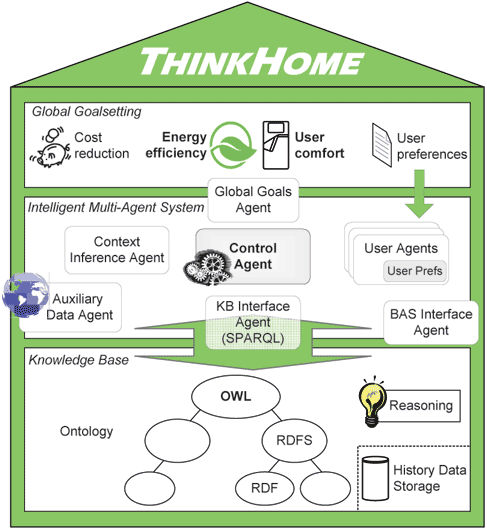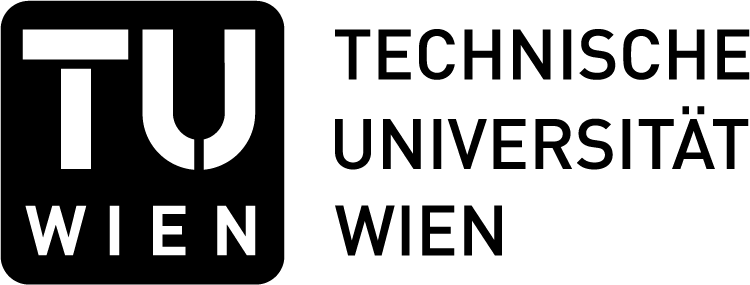Thinkhome
Multiagent System | KB and Ontology | Control Strategies | Simulation Environment
· Multiagent System
The intelligence part of the ThinkHome system is implemented as a multiagent system (MAS). MAS is a powerful logical methodology that perfectly fullfill the requirements of complex scenarios from a top-down approach, mainly in terms of distributed intelligence, for providing encapsulation on a functional level and for natively supporting communication among different system parts. In addition, the use of the agent paradigm also brings along independent evolution, exchange, and maintenance of the autonomous parts that are implemented as agents. The use of well-defined interfaces helps to retain the required autonomy and even permits a possible local distribution of components.
To the Multiagent System page...
· Knowledge Base and Ontology
The task of the knowledge base is to intelligently maintain all relevant concepts that are considered to be influence factors in a smart home. Thus, it stores details on users like their preferences and profiles, current occupancy and activities (i.e., context), as well as schedules. Likewise, also weather data and building conditions are conceptualized mainly to enable dynamic optimizations. Furthermore, the KB keeps information about the building: it integrates data already collected during the architectural conception and construction process of a building, in particular comprising data on the building structure, building orientation, used materials, and related properties of these items. It also stores information on all resources (e.g., devices) that are available within the smart home, including energy-related aspects. Viewed in a global context, the KB is the foundation for the MAS and basically supports the system to infer the most appropriate building control strategies, that is, those that are most energy effcient and comfort oriented in the current situation. Additionally, the KB functions as an abstraction layer of the underlying Building Automation System (BAS). As it is not relevant for control strategies to be aware of the concrete installations in the building, but rather of the services they other, the KB provides a generic and integrated view of the different devices, networks and related functionalities to the higher system part. Taken together, this part of the system represents the shared vocabulary used by the MAS for execution of advanced control strategies. It is therefore fundamental in grounding ThinkHome.
To the Knowledge Base and Ontology page...
· Control Strategies
The control strategies supports the basis of the intelligent operation of a ThinkHome building. They are responsible for the calculation of the actions (switching commands, start/stop times and many other parameters) that are executed by the underlying BAS. The control strategies are implemented in a dedicated agent. Hence, they are embedded in the agent framework (MAS) and can access all information that is available in the system, either directly, by communication, or even by cooperation with other agents.
The control strategies are built over artificial intelligence methods and algorithms in order to acquire pervasive and context aware decision capabilities. In short, control strategies face the resolution of specific "uses cases" and applications taking advantage of the structure, resources and framework established by the MAS and KB, and also submitted to the supervision of the competent MAS agents.
To the Control Strategies page...
· Simulation Environment
Due to the difficulties to evaluate experimental approaches in the built environment, simulation is a suitable means for designing energy efficient buildings and also for checking control strategies, the application of artificial intelligence in BAS solutions and the performance optimization of holistic concepts (like ThinkHome) as a whole.
In addition, simulation is not only a tool useful in design or research phases, but a method available for advanced holistic systems to make predictions and obtain foundations for the next decision making.

Overview of the ThinkHome system
The application of automation technology to residential environments holds a lot of benefits. Still, much of the potential available in a typical present-day home automation system lies fallow since the control strategies linking sensors and actuators are not as flexible as they should be. Tuning such a system precisely to the requirements of its users and the characteristics of both building structure and building services equipment is a task reserved to those with specialist knowledge. Moreover, it is almost never done in full due to the large effort required. For the same reason, once the system is installed, necessary readjustments are foregone almost as a rule. The task gets even harder as more design disciplines are involved. Therefore, intelligent homes that utilize modern computer technology to autonomously govern and constantly adapt the building environment to optimize both user comfort and energy-consumption simultaneously are in dire need. ThinkHome is an incarnation of such an intelligent home of the future that utilizes artificial intelligence (AI) to improve control of home automation functions provided by dedicated automation systems. It is able to detect and utilize patterns to provide a better, more energy-efficient, yet comfort oriented, control of building functions. Primary targets are functions that require comparably high amounts of energy, such as those found in heating/ventilation and air-conditioning, and lighting/shading. For an optimization, the system must be capable of detecting user interactions and desires, to identify patterns in these data and to be able to learn and adapt to its environment. ThinkHome must therefore be able to perceive its environment, especially the home in which it is employed. It has to learn environmental parameters such as thermal inertia and combine this knowledge together with various parameters and data found in and around today’s buildings (presence, occupancy, temperature, daylight …) to find an optimal strategy for controlling the environment. Ultimate goal of the ambitious project is to prove that ThinkHome can fulfill all the demands mentioned above. This includes the definition of a knowledge base that holds all relevant data. This knowledge base is fundamental to enable our vision of optimized, AI based control strategies that allow maximizing energy efficiency. To maximize the usefulness of AI, different approaches have to be investigated and evaluated regarding their performance and output when both energy efficiency and user comfort are taken into account.
An agent based framework is home for agents that act on behalf of users (avatars) and has the artificial control strategies embedded. Moreover, it provides access to the knowledge base and interfaces to the underlying building control systems. The project outcome will be verified by a prototype implementation that will be installed into an existing building automation model. Additionally, a simulation shall highlight both the applicability and benefits that ThinkHome holds in real world projects.
From its beginning, all results of the ThinkHome project will be made available to the public through open workshops and via a dedicated project homepage.

